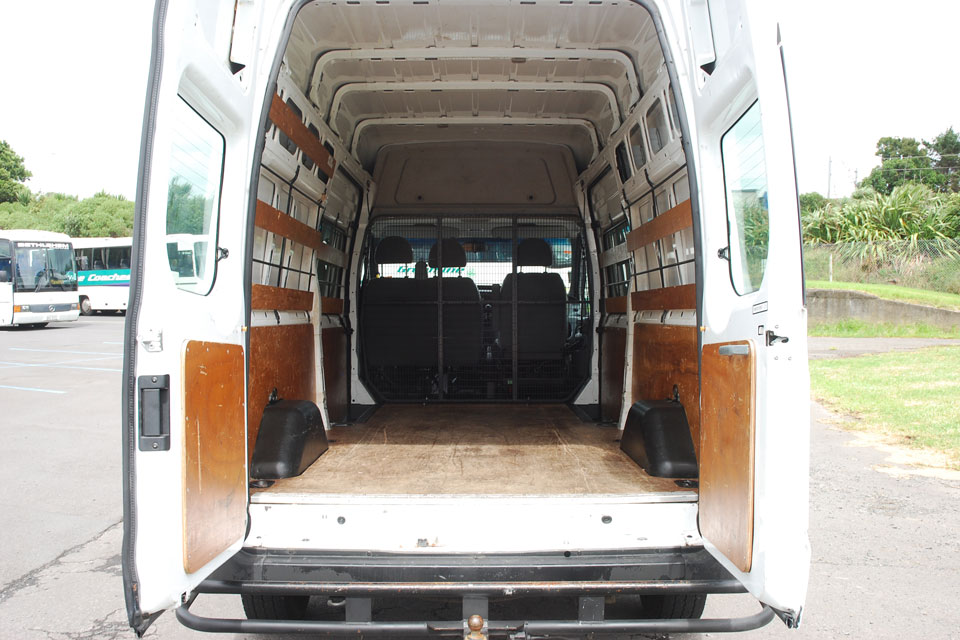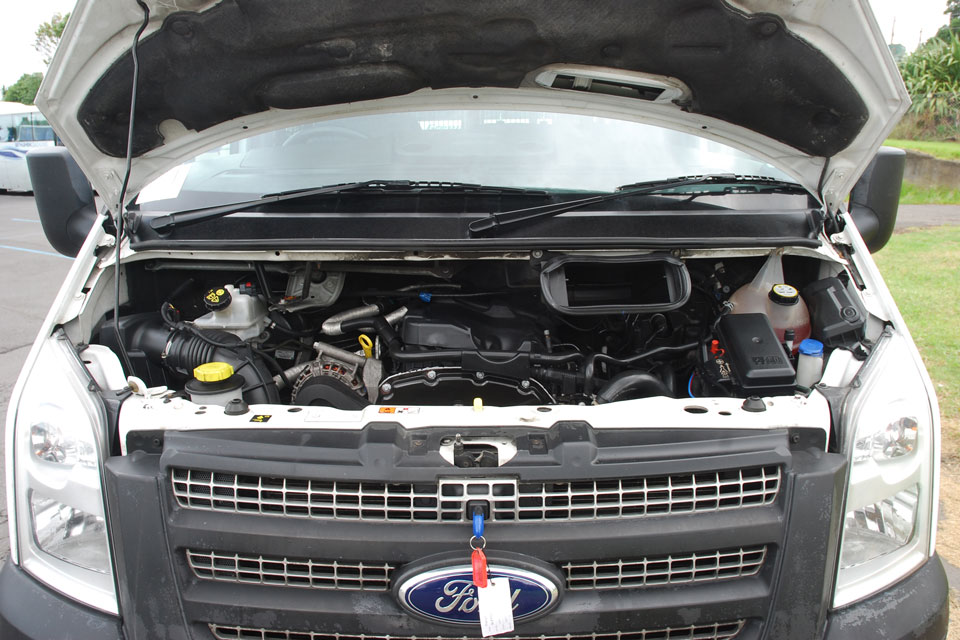Ford Transit 2006-2014 used car review
The Ford Transit is a practical cargo van that is reasonable to drive. There are some issues to check for when you shop.

The Ford Transit is a practical cargo van that is reasonable to drive. There are some issues to check for when you shop.
Developed in Europe and built in the United Kingdom, the Ford Transit is popular with couriers, tradespeople and as a minibus. It is available in a range of lengths and roof heights, and as a single or double-cab small truck, which is commonly used for motorhome conversions.
Custom interior fit-outs and modifications have been made to many Transits to make them specialised "tools of the trade". The "Mark 7" review model shares a basic body shape with the previous generation, though is heavily revised.
Inside and out
For maximum interior volume, the Transit is a large cube shape. The review vehicle features the optional high roof and is the medium-wheelbase version. At the front is a short-angled nose, with a black plastic grille and bumpers, which hide knocks well. There are sliding doors on both sides for easy access to the load space, and rubber strips to protect the side panels. At the rear, the doors are "barn" style and open outwards in two pieces. There is a step in the rear bumper and an optional protection bar.
Rear side windows were optional when the van was sold new - they allow for little extra visibility from the driver’s seat and extra light inside, although are more fragile than the metal sides, and offer less security.
Real thought was put into the interior of the Transit that makes it great as a work vehicle. There are two glove boxes and additional lidded storage on top of the dashboard in front of the driver. A panel on top of the centre console can be used to clip documents into, and a large bottle holder can also be used for a cargo scanner.
The windscreen is heated, great for quick clearing on cold mornings. The gear stick is mounted on the dashboard, making it easy to reach, and allowing the driver to slide across and exit the van kerbside for deliveries. A handy touch is the key - which is fully sealed so is resistant to water splashes and dust. So the battery does not require replacement, it is charged through the ignition lock.
The driver’s seat is adjustable for height and tilt and feels firm though very comfortable and supportive. On the passenger side is a two-seat bench, which is comfortable, although a little bit of a squeeze for two adults, with the centre passenger’s knees, close to the dashboard. An optional cargo barrier behind the seats protects the cabin from shifting loads - an optional extra that is a must-have.
The rear of the Transit is enormous, and can take some substantial items - it is over 1.7-metres wide, nearly 1.9-metres tall and over 3.3-metres long. You can carry up to 1,498kg of payload in the van. The load floor is a little high to step in and out of repeatedly, though you can reach most of the space from outside, or have an aftermarket step fitted. Enough room to stand up makes the Transit popular for campervan conversions.
On the road
New-Zealand new Transits were fitted with a 2.4-litre turbocharged four-cylinder diesel engine, until 2012 when a more modern and fuel-efficient 2.2-litre turbocharged four-cylinder diesel was installed. They were all rear-wheel drive with a six-speed manual transmission. Import models may be fitted with the same or lower-powered versions of the engines, or the rare 2-litre petrol, and can also be front-wheel drive.
Our version has 114kW and 385Nm, and performance is quite good - the engine has lots of low down pull which reduces the number of gear changes you need to make. The gearshift is easy to reach and the clutch smooth.
The Transit is good to drive when you consider its size. The steering has a nice light feel to it and is responsive. There is some body roll, though it is not too bad - the van is comfortable to keep pace with traffic on the highway even around corners. The ride can be bouncy when empty, which is fixed with a load on board. It can be quite noisy and rattly inside.
To the side and rearward, the large twin mirrors are excellent as well. Reversing cameras were not fitted, with parking sensors optional. We think a camera is a must-have, which you can do yourself from $50 or have a professional do it from $200. Our vehicle was fitted with rear protection bars which do not work with parking sensors.
The Transit has a decent tow rating, although be aware that with a laden van and trailer the vehicle may reach a point where a heavy transport licence is required. It will pull 750kg unbraked (a medium-size garden trailer) and 2,800kg braked (a large trailer boat).
Safety
This generation Transit carries a three-star ANCAP safety rating, which is competitive with other vans of its era. Standard safety features include a driver’s airbag and anti-lock brakes with electronic brakeforce distribution. Our van was fitted with the optional passenger airbag and electronic stability control. Side airbags are also an optional extra.
There are no child seat mounts in the Transit. All three front seats feature a full three-point belt - some vans’ middle seat only get a lap-belt.
Reliability
In the context of the mileages they cover and the tough jobs they do, the Ford Transit is reasonably reliable - although their tough life does expose some issues. The engine uses a timing chain which will not require regular replacement, yet on high mileage examples, a rattle may indicate the chain is worn and will require replacement.
Earlier 2.4-litre models can have an issue where the engine starts to cut out or does not want to rev. This is caused by a faulty vapour valve and will cost around $600 to fix.
This may also cause exhaust smoke. A rebuild or replacement of the turbo will cost more than $3,000.
Ensure the transmission shifts cleanly and smoothly, as heavy use can cause them to fail. A rattle from under the vehicle could indicate two things, either a faulty dual-mass flywheel or failed driveshaft bearings - both common faults. A dealer will easily be able to diagnose either issue.
Look for corrosion, particularly around the corners and under the floor of the vehicle. They are not known to be particularly prone to rust, however, bangs and scrapes can breach the body’s protection and allow it to occur.
Cost of ownership
The Transit is expected to do high mileages, so it has a long 30,000km gap between each service - yet if you don’t cover that distance each year, a quick annual safety check is recommended. Services vary in cost from around $600 to just under $1,000.
RightCar estimates a 2.2-litre Transit will cost $2,470 per year in fuel and Road User Charges. The 80-litre diesel tank will cost $116 to fill at $1.45 a litre and should take you 940km until the fuel light comes on - though the bigger your load, the higher your fuel use.
A vehicle licence for the Transit is at a goods vehicle rate and will cost $183.31 per year.
Trade Me Insurance estimates cover for a Transit valued at $32,340 can cost from $61.92* per month. This price is for private use, and business users will need additional protection.
Buyers’ guide
This generation Transit is available on Trade Me priced from $9,000 through to $48,000. The most expensive vehicles are minibus versions or disability conversions. Cargo vans like ours top out at around $35,000.
Shop for low mileage, and keep an eye on fit out. Transits were sold new with an empty load space, and most were fitted out by their first buyer for their uses, including racks, seats, workbenches or - in the case of our ex-rental vehicle - with protection panels.
A small number of United Kingdom import Transits have come into the country - mostly minibus models. These may have varying specifications.
Variants
A wide range of height, length and payload combinations are available in the Transit - sizes sold in New Zealand range from the short-wheelbase low-roof 250 up to the long-wheelbase high-roof 460. The mid-wheel base, mid-roof 350 is by far the most common. Minibus models with up to 14 seats were sold.
Standard features include manual air-conditioning, a CD player stereo, remote keyless entry, electric mirrors and electric windows (from 2010).
Timeline
- 2006 Launched internationally
- 2012 The 2.4-litre diesel is replaced by an improved 2.2-litre unit
- 2014 Replaced by new model
Details
2012 Ford Transit T350
$19,000 to $45,000 for models which have travelled 70,000 to 120,000km
2.4-litre five-cylinder turbocharged, 114kW/385Nm (claimed)
Six-speed manual, rear-wheel drive
Three-star ANCAP rating
30,000km
Full size wheel
7.9-litres per 100km (claimed)
Diesel
6403mm
1974mm
2622mm
750kg (unbraked), 2800kg (braked)
13.3m
This review covers the Ford Transit for model years 2006, 2007, 2008, 2009, 2010, 2011, 2012, 2013 and 2014.
Review vehicle supplied by Turners Cars.
*Our insurance estimates are based on a 35-year-old male with no accidents in the last two years, garaging the car in Mission Bay, Auckland. The car is not used for business and will cover 10,000km to 20,000km a year. We estimate with no option add-ons and $500 excess. Customise your estimate at Trade Me Insurance.
Image gallery
Also consider






